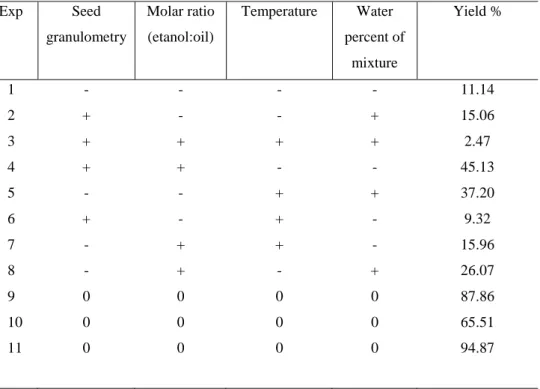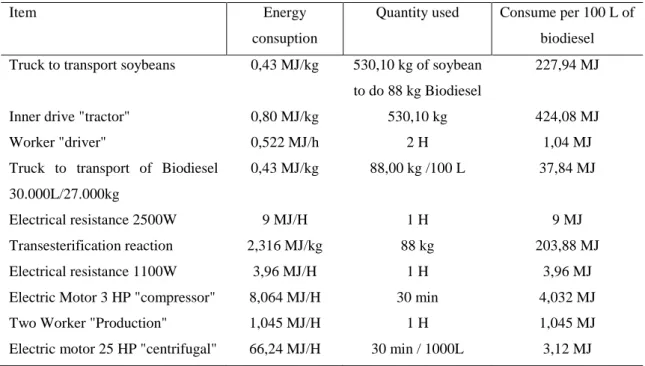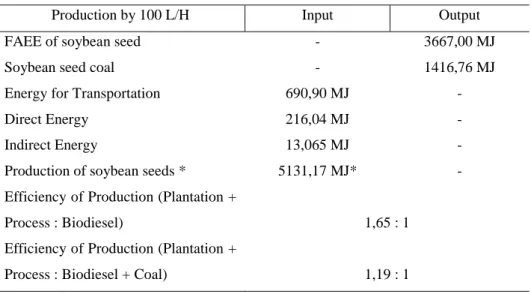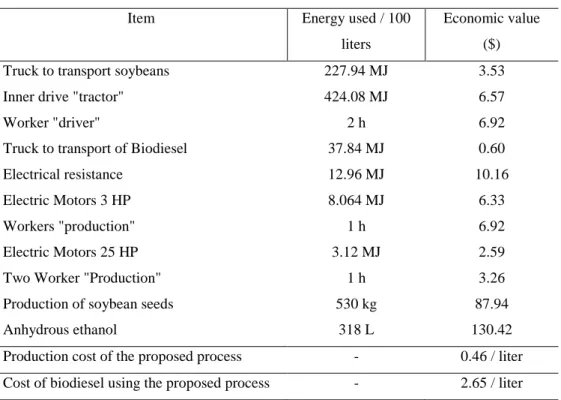Energy balance to production process of biodiesel non-catalytic using
supercritical ethanol and soybean seed
Balanço energético para o processo de produção de biodiesel não catalítico
utilizando álcool supercrítico e semente de soja
Recebimento dos originais: 02/12/2017 Aceitação para publicação: 27/12/2017
Gabriel Cassemiro Mariano
Laboratory of Process Control – LCP.Post Graduate in Chemical Engineering Institution: Federal University of Santa Catarina – UFSC
Address: 476, Trindade, Florianópolis, Santa Catarina, Brazil. E-mail: gabrielmarianoc@gmail.com
Ariovaldo Bolzan
Laboratory of Process Control – LCP.Post Graduate in Chemical Engineering Institution: Federal University of Santa Catarina – UFSC
Address: 476, Trindade, Florianópolis, Santa Catarina, Brazil. E-mail: gabrielmarianoc@gmail.com
Marintho Bastos Quadri
Laboratory of Process Control – LCP.Post Graduate in Chemical Engineering Institution: Federal University of Santa Catarina – UFSC
Address: 476, Trindade, Florianópolis, Santa Catarina, Brazil. E-mail: gabrielmarianoc@gmail.com
Dyego Amaral Silveira
Laboratory of Process Control – LCP.Post Graduate in Chemical Engineering Institution: Federal University of Santa Catarina – UFSC
Address: 476, Trindade, Florianópolis, Santa Catarina, Brazil. E-mail: gabrielmarianoc@gmail.com
Rafael Dias
Laboratory of Process Control – LCP.Post Graduate in Chemical Engineering Institution: Federal University of Santa Catarina – UFSC
Address: 476, Trindade, Florianópolis, Santa Catarina, Brazil. E-mail: gabrielmarianoc@gmail.com
ABSTRACT
The non-catalytic transesterification of vegetable oil using an alcohol in supercritical conditions has been highlighting as an alternative method for production of biodiesel. To supercritical biodiesel production was developed bench reactor with a volume of 150 mL and capacity to support 300 bar pressure in temperature of 350 ° C. Experiments were conducted at different temperatures, granulometries, molar ethanol: oil and water concentrations. To characterize the biodiesel were
been done chromatographic analyzes and mass balance identifying the quality and yield of esters. Biodiesel showed good quality for the composition of esters and had a maximum yield of 94.87%. The roasted soybean presented calorific potential of 2203.17 kcal / kg. To characterize the byproduct, roasted soybean, we performed a thermal analysis (TGA-DTA). To quantify the energy consumed and energy produced "Input / Output" in the production process of biodiesel has been done an energy balance. For the proposed process was finding an energy relationship of 1,19:1, and a cost of 8.49 reais per liter of Fatty Acid Ethyl Ester (FAEE) produced with supercritical ethanol and soybean seed. It was identified that the process of producing biodiesel from oil seeds can be viable when used a seed cheap.
Keywords: Supercritical. non-catalytic transesterification. Fatty Acid Ethyl Ester. Energy Balance.
RESUMO
A transesterificação não catalítica de óleo vegetal usando um álcool em condições supercríticas tem sido destacada como um método alternativo para a produção de biodiesel. Para a produção de biodiesel supercrítico foi desenvolvido um reator de banco com um volume de 150 mL e capacidade para suportar a pressão de 300 bar a uma temperatura de 350 °C. Experimentos foram conduzidos a diferentes temperaturas, granulometrias, etanol molar: concentrações de óleo e água. Para caracterizar o biodiesel foram feitas análises cromatográficas e balanço de massa identificando a qualidade e o rendimento dos ésteres. O biodiesel mostrou boa qualidade para a composição de ésteres e teve um rendimento máximo de 94,87%. A soja torrada apresentou potencial calorífico de 2203,17 kcal / kg. Para caracterizar o subproduto, soja torrada, realizamos uma análise térmica (TGA-DTA). Para quantificar a energia consumida e a energia produzida "Entrada / Saída" no processo de produção de biodiesel foi feito um balanço energético. Para o processo proposto foi encontrar uma relação de energia de 1,19: 1 e um custo de 8,49 reais por litro de éster de etileno de ácido gordo (FAEE) produzido com etanol supercrítico e semente de soja. Foi identificado que o processo de produção de biodiesel a partir de sementes de óleo pode ser viável quando usado uma semente barata.
Palavras-chave: Supercrítico. transesterificação não catalítica. Ester de etilo com ácidos
gordurosos. Equilíbrio energético.
1 INTRODUCTION
As the market for diesel engines the possibility of using a renewable fuel is conducted to search for alternative routes for the production of biodiesel. Among various routes surveyed has been highlighting the supercritical transesterification.[8]
Some advantages of the process of transesterification of oil in a supercritical alcohol are the reaction time reduced and not need for standardization of raw material.
Although a detailed procedure necessary to convert vegetable oil esters biodiesel it is verified that the process transesterification of vegetable oil is for the most part viable.[6] Chemically the transesterification of oils means to take the complex fatty acid triglyceride transforming on three molecules of fatty acid ester (biodiesel) and one glycerol molecule. The alcoholysis with methanol
(methanolysis) is technically more feasible than with ethanolysis, but methanol is an extremely toxic and methyl biodiesel is not a completely renewable fuel. Ethanol highlights about methanol due to the fact of being a derivative agriculture, less environmentally questionable and a renewable source, although it is more expensive and less reactive. [8],[19]
To transesterification using oil verified that the temperature is the factor that most influences the speed and performance of the transesterification reaction.[13] The temperature directly affects the reaction kinetics, however, for the energy balance the need for high temperatures can be a problem when analyzing the economic and energy efficiency of the process, making the process financially unfeasible because of the high energy consumption.
The energy balance has been developed to assist the realization of the planning processes involving energy supply. This treatment has been an indispensable tool to the viability assessment of all energy process. [14]
The energy balance is the difference between energy consumed and energy produced in the process. The energy consumed in the system may be divided into transport energy that is the energy used in the transportation of raw materials and final product; direct energy this is the energy used in the form of fossil fuels, electricity, steam and firewood; indirect energy, this is the energy consumed in the form of agricultural inputs, equipment, machinery, buildings and transportation.[12]
The production process proposed in this paper used the fresh soybean seed and ethanol as a raw material. The objective was to present an innovative and alternative process for the production of biodiesel from soybean seed. Sought to identify the yield of esters and conducting a study for energy balance and cost of the proposed process.
2 MATERIAL AND METHODS
For biodiesel production from ethanol and soybean seed it was developed a batch reactor with capacity of supporting pressures of 300 bar at temperatures of 350 ° C. A flowchart to define the stages of the production process of the ester was made. The flowchart for the process of production of biodiesel is presented in Figure 01.
Figure 01 - Flowchart of biodiesel production by supercritical process.
The biodiesel was produced from soybeans and absolute ethanol in supercritical conditions. The experimental procedures were filling the reactor with soy seed and ethanol as molar ratio ethanol: soybean oil predefined. It was assumed that 20% of the weight of the seed is soybean oil. The heating of the reactor was done with a ceramic electrical resistance 220V, 2500W.
The investigation of the best experimental conditions to obtain the best yields of esters have been done from the factorial experimental planning with triplicate central point. In Table 01 can be checked factors and levels evaluated.
Table 01 - Factors and levels evaluated.
Factors\Levels -1 0 +1
Seed granulometry entire seed broken seed (2 parts)
irregular broken Seed
(mesh nº 5)
Molar ratio (etanol:oil) 10:1 20:1 30:1
Temperature 245.0 ºC 255.0 ºC 265.0 ºC
Water percent of mixture 17 % 11 % 5 %
The analysis of the esters were carried in a gas chromatograph. Was identified an average yield of 83.06% w / w. Were used the guidelines of technical standards ASTM D6584 / ISO
EN14105. The concentration of biodiesel was calculated considering the volume of the sample dilution and the seed mass placed in the reactor.
An analysis of the potential calorific was conducted to analyze the soybean seed toast. This analysis was performed to identify if coal soybean seed could have calorific potential to be used as coal for thermal power. Was done a Thermogravimetric Analysis (TGA-DTA) under controlled conditions in the atmosphere with nitrogen, seed mass of 10 mg and heating rate 10 ° C per minute to 900 ° C.
To make the energy balance of the process were considered stages of production and distribution of biodiesel. The energy consumption for the cultivation of soybean seed was obtained from Gazzoni et al. (2005). Was made an economic balance for the proposed production process. Economic calculation assumed that the calorific value of diesel is 42.50 MJ/kg to 0.84 g/cm ³ and the market value of diesel is R$ 2.14 per liter. [2],[4] The cost of the worker was calculated based on the average cost of a worker in Brazil set to R$ 1,980.00 month with additional 30%. It was considered that the employee works 44 hours per week. The cost of electricity was obtained from the distributor Centrais Elétricas de Santa Catarina S.A., was considered the value R$ 9.11 per kW.[7] The economic cost for soybean seed was considered to R$ 0.536 per kg. [1]
3 RESULTS AND DISCUSSION
3.1 RESULTS OF THE PRODUCTION PROCESS
The best yield w/w of esters was 94.87% for the experiment 11 after 10 minutes of reaction in supercritical state. The experiment was performed in the conditions of granulometry grain broken irregular molar ratio (ethanol: oil) 20:1 255 ° C temperature and water content 11% concentration of water. The yields calculated and experimental conditions of the planning performed are shown in Table 02.
Table 02 - Percent yield of the experimental planning. Exp Seed granulometry Molar ratio (etanol:oil) Temperature Water percent of mixture Yield % 1 - - - - 11.14 2 + - - + 15.06 3 + + + + 2.47 4 + + - - 45.13 5 - - + + 37.20 6 + - + - 9.32 7 - + + - 15.96 8 - + - + 26.07 9 0 0 0 0 87.86 10 0 0 0 0 65.51 11 0 0 0 0 94.87
After transesterification reaction was possible to verify the existence of two phases, one liquid and one solid oily colored black with residues of seed. The seed roasted was retained in the reactor with the same format as the initial grain. It was found that after the reaction for biodiesel purification it was necessary to separation of the components of the wort by centrifugation and evaporation to separate the ethanol from the unreacted ester. After separation it was obtained a FAEE with the presence of esters palmitate, stearate, oleate, linoleate and linolenate. The range of FAEE produced was C16 - C18: 3 with higher concentrations of oleate (C18: 1) it is considered a biodiesel with good quality. [3],[9],[17]
After separation operations was made a Thermogravimetric Analysis (TGA-DTA) on the seed retained in the reactor. It was possible to verify that the soybean biomass was stable during the degradation, the grain burned evenly across your external profile and not ejected sparks. The calorific power of the grain was 2203.17 kcal / kg. The results indicate that coal soybean seed can be considered a good coal with energetic properties compared to the calorific potential of palm fiber (2000.00 kcal / kg) and 40% wood 48% water (2400.00 kcal / kg).
3.2 ENERGY BALANCE
The energy balance for the proposed process was calculated by step and feature as standard. In the step of transporting the feedstock to the biodiesel industry were considered the energy costs of labor and transportation equipment. The cost of labor has been reported according to the
classification of work, number of employees and the distance of raw materials to the production industry. It was considered that a worker with moderate workload consumes 4180 - 6688 kJ in 8 hours.
To calculate the energy consumption of electric motors and resistance were observed relationships between power, voltage, uptime and efficiency. For the chemical reaction the energy consumption was calculated based on the energy involved in the transesterification process, where triglycerides are converted into ethanol and esters. The energy released at the end of the process will be equivalent to that absorbed to rebuild the links of products, glycerol and esters.[20] Was carried out the mass balance considering the molecular weight of the reactants and energy needed to break the bonds of the molecules. For the transesterification reaction requires three moles of ethanol for each mole of triglyceride, the molecular weight of soybean oil is 884 grams of ethanol for every mole molecular weight of 46 grams. The energy released by the breakdown of each chemical bond is 357.5 kJ CO in the vapor state, so the energy released by the breaking of the bonds of carbon and oxygen is 1072.5 kJ. Stoichiometrically to obtain 0.93 kg of biodiesel has the release of 2.145 kJ.[11].[20]
The calculated energy consumption for transportation energy, direct energy and indirect energy for the proposed process is presented in Table 03.
Table 03 - Consumption of transportation, energy, direct and indirect energy for the proposed process.
Item Energy
consuption
Quantity used Consume per 100 L of biodiesel Truck to transport soybeans 0,43 MJ/kg 530,10 kg of soybean
to do 88 kg Biodiesel
227,94 MJ
Inner drive "tractor" 0,80 MJ/kg 530,10 kg 424,08 MJ
Worker "driver" 0,522 MJ/h 2 H 1,04 MJ
Truck to transport of Biodiesel 30.000L/27.000kg
0,43 MJ/kg 88,00 kg /100 L 37,84 MJ
Electrical resistance 2500W 9 MJ/H 1 H 9 MJ
Transesterification reaction 2,316 MJ/kg 88 kg 203,88 MJ
Electrical resistance 1100W 3,96 MJ/H 1 H 3,96 MJ
Electric Motor 3 HP "compressor" 8,064 MJ/H 30 min 4,032 MJ
Two Worker "Production" 1,045 MJ/H 1 H 1,045 MJ
Electric motor 25 HP "centrifugal" 66,24 MJ/H 30 min / 1000L 3,12 MJ Sources: Adapted from [5]Assenheimer, 2009; [14]Macedo, 1998; [18]Pimentel, 1980.
The energy balance, input / output, for biofuel ethanol in the central-southern Brazil is 3:8.
[15] For ethyl biodiesel done via catalytic process in batch the energy balance input / output is 1.58:1
when used palm oil, 1.21:1 when used soybean oil, and 2.23:1 when used castor oil via catalytic process. For the production of methyl biodiesel was identified relationships of 2.33:1 when used palm oil, soy oil to 5:1 and 2.1:1 for castor oil.[2],[15],[16],[21] The studies considered the steps of planting seeds and consumption related to oil extraction from seed. The step of planting and oil extraction are the most representative for the energy balance of biodiesel catalyst. [2],[10]
For the energy balance of the process of production of biodiesel energy values input / output are shown in Table 04.
Table 04 - Calculated energy consumption and accumulation.
Production by 100 L/H Input Output
FAEE of soybean seed - 3667,00 MJ
Soybean seed coal - 1416,76 MJ
Energy for Transportation 690,90 MJ -
Direct Energy 216,04 MJ -
Indirect Energy 13,065 MJ -
Production of soybean seeds * 5131,17 MJ* -
Efficiency of Production (Plantation +
Process : Biodiesel) 1,65 : 1
Efficiency of Production (Plantation +
Process : Biodiesel + Coal) 1,19 : 1
Source:*[10]Gazzoni et al., 2005.
The energy efficiency, input / output, for the proposed process was 1.65:1. If considered the energy gain due possible to use seed roasted coal is obtained as the ratio of 1.19:1. The energy balance calculations were done for an production of 100 liters of biodiesel. It was found 6051.17 MJ consumption of generating products capable of providing 5083.76 MJ.
The energy consumption of seed production stage was higher.[2],[10] Was identified the power consumption of MJ 5131.17 to 530.1 kg of soybean seed produced. The energy transport is the second largest energy consumption totaling 690.90 MJ. The indirect energy was less representative of the total energy being consumed 13.065 MJ.
Based on energy consumption was performed economic balance for the process proposed. The real amounts considering a production process 100 liters per hour is shown in Table 05.
Table 05 - Amounts in Reais calculated considering the proposed process for the production of 100 liters biodiesel per hour.
Item Energy used / 100
liters
Economic value ($)
Truck to transport soybeans 227.94 MJ 3.53
Inner drive "tractor" 424.08 MJ 6.57
Worker "driver" 2 h 6.92
Truck to transport of Biodiesel 37.84 MJ 0.60
Electrical resistance 12.96 MJ 10.16
Electric Motors 3 HP 8.064 MJ 6.33
Workers "production" 1 h 6.92
Electric Motors 25 HP 3.12 MJ 2.59
Two Worker "Production" 1 h 3.26
Production of soybean seeds 530 kg 87.94
Anhydrous ethanol 318 L 130.42
Production cost of the proposed process - 0.46 / liter Cost of biodiesel using the proposed process - 2.65 / liter
The economic balance indicated that the cost of manufacture was $ 0.46 per liter. When was considered the cost of production using soybean seed the cost of a biodiesel liter was $ 2.65.
An auction practiced by the "National Agency of Petroleum" had maximum selling price between $ 0.79 and 0.89, depending of the region at Brazil. Comparing the cost of biodiesel produced and the value paid by the ANP can say that the process with the use of soybean seed generates a biodiesel economically unviable for the Brazilian market. For this study, the limiting factor was the high cost of feedstock ethanol and soybean seed, soybean seed was the most representative. The use of alternative sources of seeds and low cost can be of fundamental importance to the economic viability of biodiesel production from seed and ethanol supercritical.
4 CONCLUSION
The results show that the reaction of soybean seed and ethanol in supercritical state is possible to obtain biodiesel with good properties. Statistical analysis indicated yields of up to 94.87%.
The process of biodiesel production using seed soybean "in natura" and ethanol in supercritical state showed a energy input /output 1.19:1. For economic balance was find that the proposed process results in a biodiesel up to the value practiced in the biodiesel market at Brazil.
The use of alternative sources of seeds and low cost can be fundamental to economic viability of biodiesel production using supercritical ethanol and seeds.
5 ACKNOWLEDGMENT
This work was supported by CNPq, National Council for Scientific and Technological Development – Brazil.
REFERENCES
[1] - Agrobyte, Disponível em: <www.agrobyte.com.br>. Acesso em 14/11/2012.
[2] - ALMEIDA NETO, J.A.. CRUZ, R.S., ALVES, J.M., PIRES, M.M., ROBRA, S., PARENTE, E. Balanço energético de ésteres metílicos e etílicos de óleo de mamona. Paraíba, 2004.
[3] - ANITESCU, G., DESHPANDE A., TAVLARIDES, L. L., Integrated sechnology for supercritical biodiesel production and power cogeneration. Energy and Fuels, v 22, p. 1391– 1399, 2008.
[4] - ANP, Agência Nacional do Petróleo, Disponível em: <www.anp.gov.br>. Acesso em 14/11/2012.
[5] - ASSENHEIMER, A., CAMPOS, A. T., JÚNIOR, A. C. G., Análise energética de sistemas de produção de soja convencional e orgânica. Ambiência – Revista do Setor de Ciências Agrárias e Ambientais, 2009. v. 5, p. 443-455.
[6] - BALA, B. K. Studies on biodiesels from transformation of vegetable oils for diesel engines. Energy Edu Sci Technol , 2005, v. 15,p. 1–43.
[7] - Centrais Elétricas de Santa Catarina S.A. – Celesc, Disponível em: <www.celesc.com.br>. Acesso em 14/11/2012
[8] - DEMIRBAS, A. Biodiesel production via non-catalytic SCF method and biodiesel fuel characteristics. Energy Conversion and Managenment, 2006, v. 47, p. 2271–2282.
[9] - DEMIRBAS, A. Comparison of transesterification methods for production of biodiesel from vegetable oils and fats. Energy Conversion and Managenment, v. 49, p. 125 - 130, 2008.
[10] - GAZZONI, D. L., FELICI, P. H. N., CORONATO, R. M. E. S., RALISCH, R., Balanço energético de girassol e soja para produção de biodiesel. Biomassa & Energia, 2005, v. 2, p. 259-265.
[11] - GHESTI, G. F., Estudo de catalizadores para obtenção de biodiesel por transesterificação e determinação de rendimento por espectroscopia raman. Instituto de Química, Universidade de Brasília, DF, 2006, 150p. Dissertação de Mestrado.
[12] - GÓES, P. S. A., O Papel da Petrobras na Distribuição de Biodiesel: Perspectivas de Produção e Distribuição do Biodiesel de Mamona, Ed. UFBA, 2006, 64p.
[13] - KUSDIANA , D., SAKA, S., Biodiesel fuel from rapeseed oil as prepared in supercritical methanol. Fuel, 2001, v. 80, p. 225-230.
[14] - MACEDO, I. C., Greenhouse gas emissions and bio-ethanol production. utilization in Brazil. Biomass & Bioenergy, 1998, v. 14, p. 77-81.
[15] - MACEDO, I. C., Balanço das emissões de gases do efeito estufa na produção e uso do etanol no Brasil. Governo do Estado de São Paulo, Secretaria do Meio Ambiente, São Paulo, 2004.
[16] - MARZULLO, R. C. M., Inventário do ciclo de vida do óleo de soja para a produção de biodiesel capaz de gerar 40 GJ de energia. Escola Politécnica, Universidade de São Paulo. 2006. Dissertação de Mestrado.
[17] - NEFF, W. E.; SELKE, E.; MOUNTS, T. L.; RINSCH, W.; FRANKEL, E. N.; ZEITOUN, M. A. M. Effect of triacylglycerol composition and structures on oxidative stability of oils from selected soybean germplasm. Journal of the American Oil Chemists' Society, 1992, v. 69, p. 111-118.
[18] - PIMENTEL, D., Handbook of energy utilization in agriculture. Boca Raton, 1980, 487 p.
[19] - PINTO, A. C.; GUARIEIRO, L. L. N.; REZENDE, M. J. C.; RIBEIRO, N. M.; TORRES, E. A.; LOPES, W. A.; PEREIRA, P. A. P.; ANDRADE, J. B. Biodiesel: An Overview. Journal of Brazilian Chemical Society, 2005, v. 16, p. 1313-1330.
[20] - SERRÃO, A. A., OCÁCIA, G. C., Produção de biodiesel de soja no Rio Grande do Sul. Revista Liberato, 2007, v. 9, p. 35-41.
[21] - VIANNA, F.C. Análise de Ecoeficiência: Análise do desempenho econômico-ambiental do biodiesel e petrodiesel. Escola Politécnica, USP. 2006. Dissertação Mestrado.




